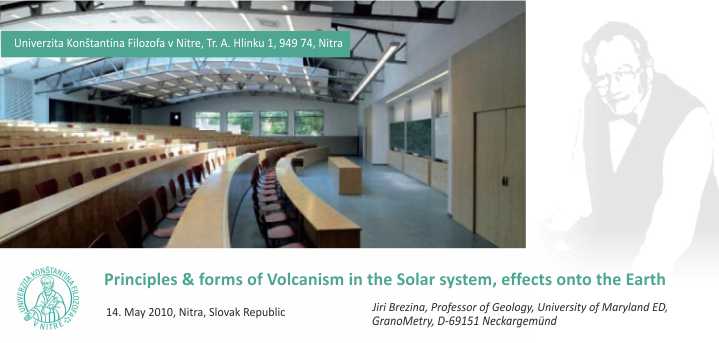- Details
- Last Updated on Tuesday, 02 July 2013 16:07
 Teaching & Presentations | Invited presentations | Nitra 14-MAY 2010
Teaching & Presentations | Invited presentations | Nitra 14-MAY 2010
Volcanism in the Solar system

Volcanoes are places where heat escapes from the interior of a solid cosmic body (planet, satellite etc.) by fluid convection onto its surface, the heat then radiates into space. The greatest sources of heat are the collisions of variously large bodies with each other. The frequency of these collisions has decreased logarithmically since the formation (origin) of the Solar system so that now, almost 5 billion years later, the collisions are (luckily) rare.
![]() Impacts of small bodies are still frequent, but their small mass does not generate enough energy to penetrate an atmosphere with at least the Earth’s atmosphere density and contribute to the heating of the body's solid surface.
Impacts of small bodies are still frequent, but their small mass does not generate enough energy to penetrate an atmosphere with at least the Earth’s atmosphere density and contribute to the heating of the body's solid surface.
![]() Impacts of such small bodies (meteorites & micrometeorites) onto the surface of bodies (having negligible or almost no atmosphere) erode them only: the small heat rise is less than the heat that escapes by radiation into space.
Impacts of such small bodies (meteorites & micrometeorites) onto the surface of bodies (having negligible or almost no atmosphere) erode them only: the small heat rise is less than the heat that escapes by radiation into space.
The next source of heat is the radioactivity of mostly heavy elements, which also has decreased logarithmically (according to the constant half-life specific for each radioactive isotope) since the Solar system's formation.
![]() Since smaller bodies have a greater specific surface, they cool more rapidly.
Since smaller bodies have a greater specific surface, they cool more rapidly.
![]() The volcanic part of geothermal heat is, therefore, visible evidence that the heat is being formed there even now.
The volcanic part of geothermal heat is, therefore, visible evidence that the heat is being formed there even now.
![]() This current heat source is the gravitational (tidal) flexing of the neighbor cosmic bodies, which causes the tidal heating.
This current heat source is the gravitational (tidal) flexing of the neighbor cosmic bodies, which causes the tidal heating.
![]() The tidal flexing is independent of the age of the bodies; it does not change with time.
The tidal flexing is independent of the age of the bodies; it does not change with time.
![]() It is caused by gravitational fields of the neighbor bodies and by their deformability.
It is caused by gravitational fields of the neighbor bodies and by their deformability.
The fastest tidal movement is in the atmosphere (mainly the stratosphere, often at supersonic speed), then the hydrosphere, and the slowest is the lithosphere (I know yet about neither observations nor mathematical models on mantle and core).
![]() In the solid crust, the flexing is focused onto the great discontinuities, which, on the Earth, are mainly the subduction zones of the tectonic plates.
In the solid crust, the flexing is focused onto the great discontinuities, which, on the Earth, are mainly the subduction zones of the tectonic plates.
![]() Whereas the lithospheric drift is in the order of a few cm/year, the tidal shift is 2-4x/day, in average 3x/day, which is about 1000-times faster.
Whereas the lithospheric drift is in the order of a few cm/year, the tidal shift is 2-4x/day, in average 3x/day, which is about 1000-times faster.
![]() Therefore, there is a gravitational friction about 1000-times more intensive.
Therefore, there is a gravitational friction about 1000-times more intensive.
The solar system bodies, after their origin, first have been stabilizing their heliocentric (planetocentric) orbits, the greater bodies into one plane and one direction, and minimized their orbital eccentricity. All gaseous and “solid” bodies over certain size are gravitationally deformable: the internal friction during their deformation change consumes the orbital and rotational energies.
![]() Both the motions slow down up to the energetically economic resonance synchronization of both periods: first to harmonic multiples, finally 1:1.
Both the motions slow down up to the energetically economic resonance synchronization of both periods: first to harmonic multiples, finally 1:1.
![]() The nearest example of the 1:1 synchronization is the rotation of Moon with its orbit around the Earth.
The nearest example of the 1:1 synchronization is the rotation of Moon with its orbit around the Earth.
![]() With its end, also the Moon’s volcanism terminated (about 3 billion years ago).
With its end, also the Moon’s volcanism terminated (about 3 billion years ago).
![]() The material of the originally molten bodies differentiated gravitationally into the heavy core, middle heavy mantle and light crust.
The material of the originally molten bodies differentiated gravitationally into the heavy core, middle heavy mantle and light crust.
![]() The differentiation includes also a degassing, which formed atmosphere and sometimes (on the Earth) also hydrosphere.
The differentiation includes also a degassing, which formed atmosphere and sometimes (on the Earth) also hydrosphere.
On the terrestrial planets, the volcanism is mostly silicate (on the Earth, except for carbonatite-volcanism in South Tanzania, magnetite-v. in Chilean Andes), on the more distant from the Sun non-silicate volcanism: on Io sulfur, on the next satellites a cryovolcanism of melting and boiling of water (Europa, Enceladus), of solid methane (Titan), of nitrogen (Triton) etc.. The volcanic gases, their composition, development of the Earth hydrosphere and atmosphere. Types and properties of the Earth volcanism according to the basicity of the silicate magma.

